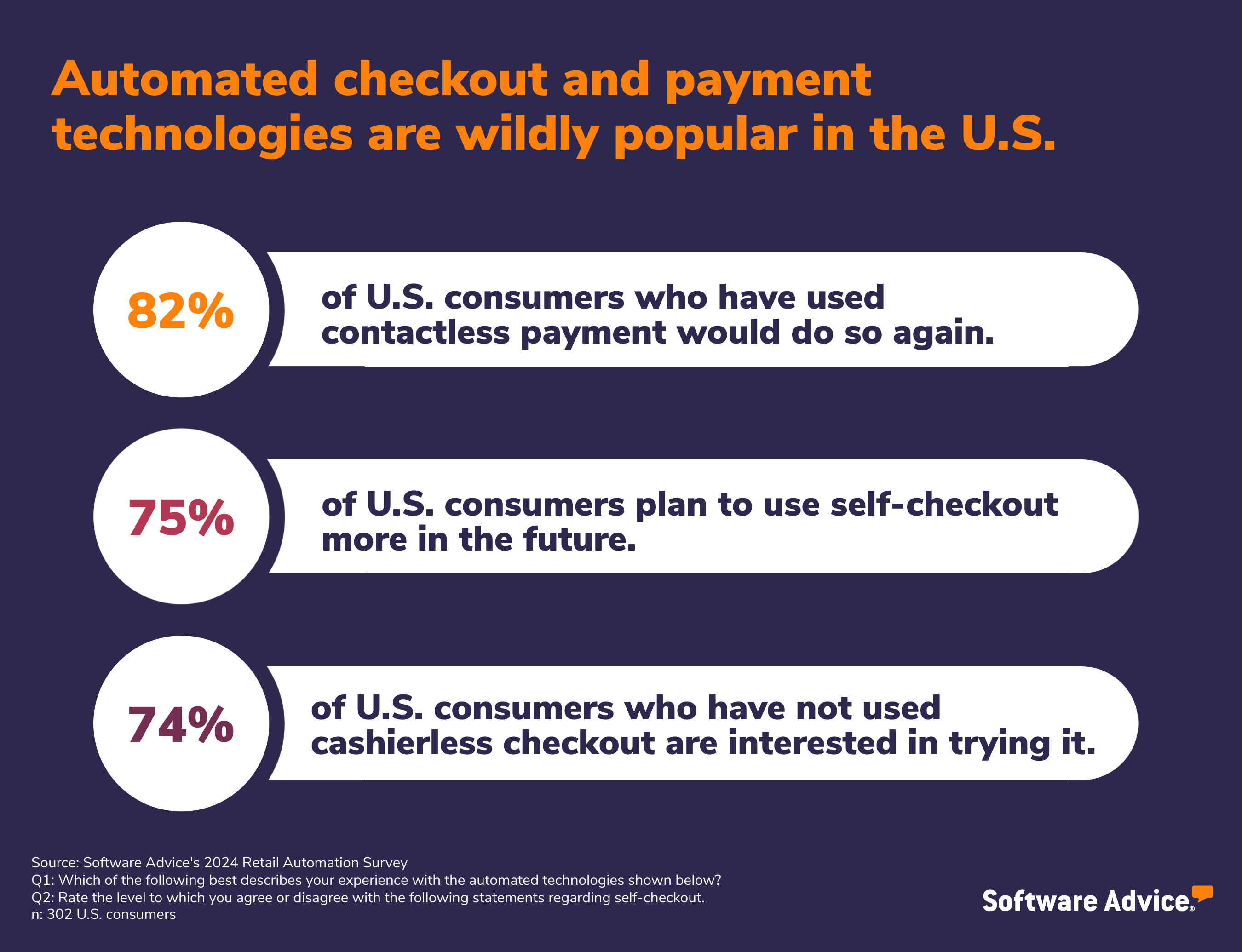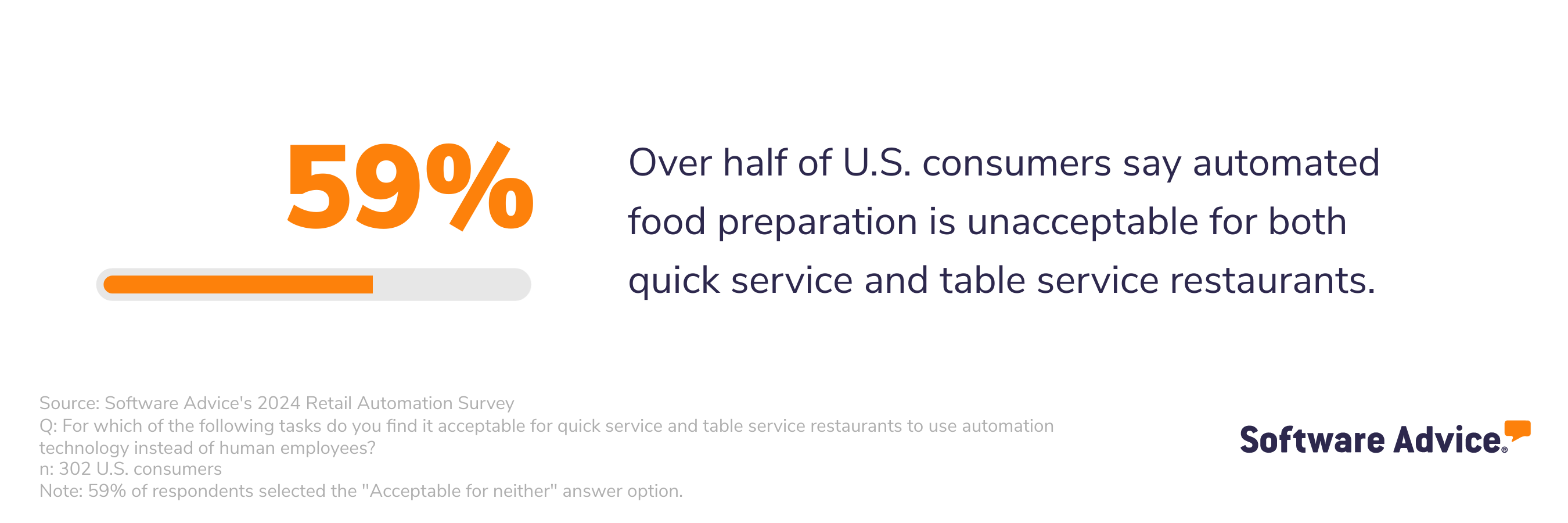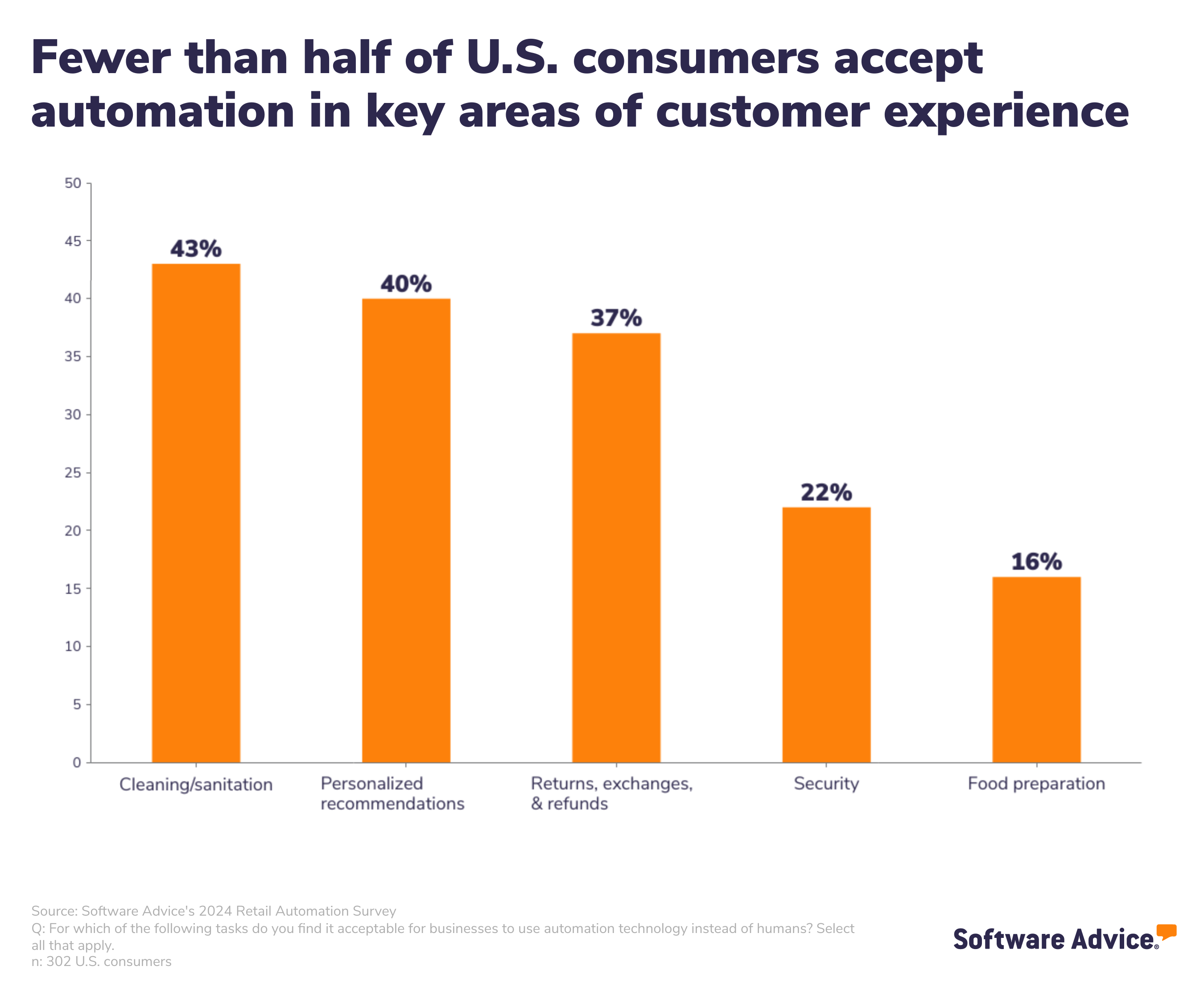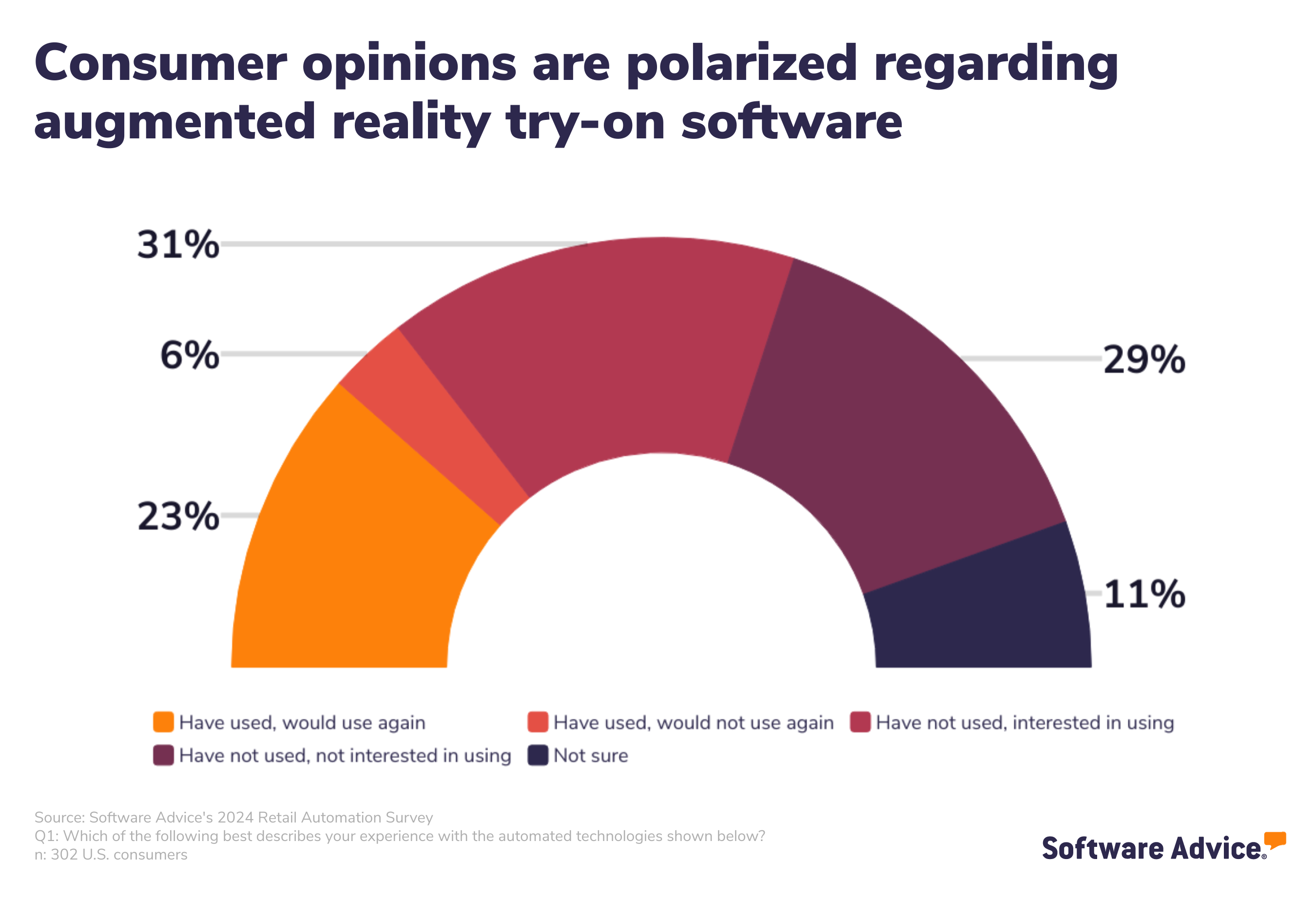How Automation Enhances (or Hinders) Sensory Experiences in Retail and Food Service
Automation technology is all the rage in the retail and restaurant industries, with more businesses springing for cutting-edge software with an eye on reducing front-of-house payroll costs.
However, business leaders need to consider how automated tech either enhances or hinders the sensory aspect of shopping and dining out, which is another critical aspect of in-person experiences that can make or break customer loyalty.
Software Advice’s survey of more than 300 U.S. consumers* indicates that while some automated tech can introduce speed and efficiency to shopping and dining out, it can’t deliver the personalization, sensory richness, and safety consumers want from their experiences at retail stores and restaurants.
Retail and restaurant business leaders should limit their in-store tech investments to those that customers say they want, while focusing on creating excellent customer experiences through the human touch and an engaging sensory atmosphere.
Key insights
Only 8% of U.S. consumers say more automation would improve their in-store retail shopping experience.
Among U.S. consumers who have not used augmented reality (AR) try-on software, 51% are interested in doing so, while 49% are not.
40% of consumers find it acceptable for businesses to rely on automation to provide personalized recommendations.
74% of US consumers say customer service at restaurants is very important, while 29% say the same of retail and grocery stores.
Customers don’t want to automate personalization and sensory aspects of in-person customer experiences
Today, a typical visit to a retail store or restaurant is a fast-paced, hybrid digital-physical experience. At every point along the journey, we interact more frequently with automated technology and less often with human employees.
For instance, we research products online before we think about leaving home. If what we want is in stock, we order curbside or stop in for a quick trip at a nearby brick-and-mortar location.
When shopping in-store, most of us take out our smartphones to check online prices against what we see on the shelf (66%) and browse ratings and reviews before we put products in our cart (64%). At restaurants, we use our phones to scan QR codes to browse and order from online menus. Finally, when it’s time to pay, we head to a self-checkout kiosk or close our tab on our smartphone.
At various points throughout this journey, most of us dodge assistance from human employees if we can help it. Our reasons for opting for technology are diverse and complex—sometimes we want privacy or to avoid conversation—but mostly, we just want to get in and out of the store or restaurant quickly and back to our busy lives.

Some automation in retail stores and restaurants is a good thing, especially when the technology makes it easier or faster for customers to make transactions. Take self-checkout and contactless payment, for example, used by most consumers today. Iterations on these two automated technologies are bringing value to businesses by offering speed, convenience, and helpful information to customers.
But there’s a limit to how much of the customer experience can be stripped of the human touch before it negatively impacts customer experience. In fact, the vast majority of shoppers think we’ve reached a good stopping point with customer-facing technology—when asked what would improve their experience at retail stores and restaurants, only 8% of consumers say they want more automation. They still want humans to handle tasks that involve a high level of sensory richness, empathy, and creative problem-solving—notably cooking, product returns, personalized recommendations, and creating a clean and safe physical environment.

At the same time, business leaders in the retail industry tend to be eager early adopters of emerging technology, including automation and artificial intelligence. Advances in technology are among the most significant external factors shaping retailers’ business goals in 2024**, and 74% of surveyed businesses including retailers and restaurants said it was extremely likely or entirely certain that they would invest in AI-powered software in 2024***.
Businesses are also finding it increasingly difficult to deal with the rising costs of everything from inventory to labor, and have to make the hard choice between raising prices or laying off employees. Following California’s minimum wage increase to $20 per hour, many restaurant owners and franchisees have begun replacing staff members that previously handled food prep, ordering, and checkout with automated tech, resulting in a more impersonal experience for some customers. [1] While it’s important to manage costs effectively while avoiding unacceptable price hikes, business leaders need to prioritize the human touch when considering investments in automated tech.

Key takeaway
Business leaders should invest in automated tech that allows their employees to offload routine tasks and approach customers with patience and empathy. With greater creative bandwidth, employees can go above and beyond to provide personalized customer service, solve complex customer problems, and create rewarding sensory experiences for customers.
Use cases for automated in-store tech: what works and what doesn’t
Self-checkout and AR try-on (also called virtual try-on) tools are two great examples of how today’s retail automation tech is meeting consumers’ needs when applied to routine tasks, while falling short when customers need personalized help or sensory enrichment. Both cases point to the continued need for human employees in physical stores and restaurants to provide the right amount of swift, effective, and personalized assistance.
Self-checkout is a familiar, reliable experience shoppers want
96% of U.S. consumers have used self-checkout and would do so again.
84% say self-checkout adds efficiency to the in-person shopping experience.
79% rate their overall experience with self-checkout technology as good or excellent.
Though the technology isn’t perfect, self-checkout does, for the most part, live up to its promise of shortening checkout time and adding convenience. Shoppers prefer it to staffed checkout in most cases, except when they need to make a cash transaction or buy age-restricted products such as alcohol or tobacco.

Automation works for checkout because it’s an easily automated task that requires minimal creativity or personalization. Though having employees nearby is necessary to quickly resolve technical issues, very little human interaction is desired or needed by the customer at this point in their shopping journey. Finally, while scanning and bagging are manual tasks, they’re not as important to the overall sensory experience of shopping as, say, browsing store aisles or testing and trying on products.
Augmented reality try-on wedges tech into what should be a personal, sensory experience
Compared to self-checkout, few consumers have used this technology—only 29%.
Among consumers who have not used AR try-on, 51% are interested in trying it out, while 49% are not.
26% of users experienced an issue or delay the last time they used AR try-on software.
Augmented reality (AR) try-on technology, also called virtual try-on or VTO, uses image overlays and AI filters to let customers virtually “try on” cosmetics and clothing using their smartphone camera. The goal is to approximate the experience of trying on products in-store, with more privacy and less time spent waiting for assistance inside busy, potentially cluttered fitting rooms.
As great as that sounds, so far AR try-on has made a poor replacement for physically trying products on, and consumer opinions on the technology are polarized.

The reason this technology hasn’t taken off like self checkout likely comes down to a few reasons:
It’s trying to replace several crucial sensory aspects of product testing with information that reaches only one of our five senses: sight. Even then, virtual try-on filters produce rough approximations of what products might look like on a customer. Today’s best virtual try-on algorithm is only mildly useful insofar as it shows how a t-shirt fits a diverse set of virtual models that may or may not resemble the customer. [2] People want to take in the look, feel, smell, taste, or performance of a product while in use—it’s part of what makes an in-person shopping trip rewarding and inspires confidence in a purchase. A virtual experience doesn’t come close to replicating that.
AR try-on tech removes the human touch entirely from the try-on experience. Helpful human feedback from in-store associates that demonstrates expertise and genuine care can make or break a customer’s relationship with the retailer, driving purchasing decisions and brand loyalty. While many retailers offer live online chat for customers who need assistance, it’s not a perfect substitute for in-store assistance, particularly if digital associates don’t work directly with products on a regular basis.
AR asks consumers for personal information they don’t want to share. Previous research from Software Advice has shown that fewer than a third of consumers in the U.S. are willing to share images or videos of their face or body in exchange for personalized recommendations, which is the framework for AR try-on****.
On top of all of that, AR try-on is buggy, with over a quarter of users saying they encountered a delay or issue the last time they used it.
There are better ways to apply automation to try-on, and augmented reality to retail and food service. Brands such as Reformation have automated the garment-fetching aspect of in-store try-on, allowing their skilled store associates more time to provide knowledgeable, personalized assistance to customers. [3] Recent research supports a case for using AR to create immersive, gamified marketing content for retail brands. [4]
Key takeaway
Automated technology works for retailers and restaurants when it helps reallocate the human touch to more complex and personal tasks and preserves important sensory experiences for customers to enjoy. Any technology that seeks to unnecessarily remove opportunities for customers to connect physically or emotionally to products and store associates is unlikely to be helpful, and will instead feel forced and gimmicky. Businesses should instead use automation to lighten the routine workload for associates so they can do what they’re best suited for: delighting customers with immersive, personalized, pleasant, multi-sensory experiences that will keep them coming back.
Businesses need to focus on high-quality hiring and strategic investments in automated tech
There’s a clear boundary as to where consumers want to draw the line between automation versus human-delivered customer experiences: Consumers do not want technology to fully take over areas that ensure the safety, sensory richness, and personalization of their experience in stores and restaurants.
This does not mean retail stores and restaurants should go back to the Stone Age in these areas. After all, plenty of technology, such as customer relationship management (CRM) software, IoT kitchen appliances, and order tracking software can facilitate creativity and critical thinking by quieting some of the mental background noise of routine tasks and number crunching.
It does mean that business leaders need to focus their investments on facilitating the human touch and enhancing the key sensory details that make for a rewarding, repeat-worthy customer experience, such as inspired dishes, thoughtful store design, or clean and inviting fitting rooms.
Excellent customer service starts, of course, with employee satisfaction—another key area of investment for today’s savvy retail and restaurant business leaders. [5] Automated tools such as employee scheduling software and inventory management software lighten employees’ administrative workload, boosting their well-being and reducing attrition. [6]
Retail and restaurant leaders have a lot of options to choose from when selecting automated software. For expert assistance on where to start, try chatting one-on-one with an advisor from Software Advice for free to get personalized help and recommendations.
Sources
The Impact Of California’s $20 Minimum Wage On Fast Food Industry, Tampa Free Press
Google introduces generative AI virtual try-on tool, Retail Dive
Reformation Opens A New NYC Flagship, Taking Its Tech-Forward Retail To The Next Level, Forbes
The Future of Retail: Enable 6 Must-Have Capabilities to Thrive in the Retail Industry, Gartner
Top Trends Shaping the Retail Store Associate Experience, Gartner
Survey methodology
*Software Advice's 2024 Retail Automation Survey was conducted online in February 2024 among 2,112 respondents in the U.S. (n: 302), Canada (n: 305), Australia (n: 302), the U.K. (n: 301), France (n: 301), Germany (n: 301), and Spain (n: 300). The goal of the study was to learn how retailers and restaurants can address customer pain points with automation to ensure technology is adding efficiency to the customer experience. Respondents were screened for their experience with automation technologies at retail businesses and restaurants.
**Software Advice’s 2024 Tech Trends Survey was designed to understand the timeline, organizational challenges, adoption & budget, vendor research behaviors, ROI expectations, and satisfaction levels for software buyers.
The survey was conducted online in July 2023 among 3,484 respondents from the U.S., U.K., Canada, Australia, France, India, Germany, Brazil, and Japan, with businesses across multiple industries and company sizes (five or more employees). Respondents were screened to ensure their involvement in software purchasing decisions.
***Software Advice’s 2024 Software Buying Behavior Survey was designed to understand the makeup, triggers, budgets, and challenges of software buying teams at global businesses across multiple industries and sizes. We sought to uncover the software types these buyers are adopting, their evaluation methods, and what factors convince them to make a purchase, from vendor reputation and sales team interactions to content materials and user reviews.
The survey was conducted online in August and September 2023 among 2,499 respondents from the U.S., U.K., Canada, Australia, France, India, Germany, Brazil, and Japan, with businesses across multiple industries and company sizes (five or more employees). Respondents were screened to ensure their involvement in software purchasing decisions.
****Software Advice's 2023 AI Shopping Security Risks Survey was conducted in July of 2023 among 1,000 U.S. consumers to learn more about their attitudes and behaviors regarding artificial intelligence tools in online shopping. Respondents were screened for online shopping frequency; all respondents shop online at least once per month.